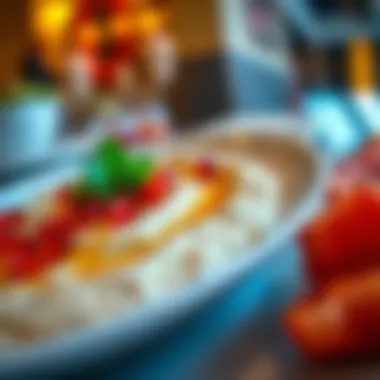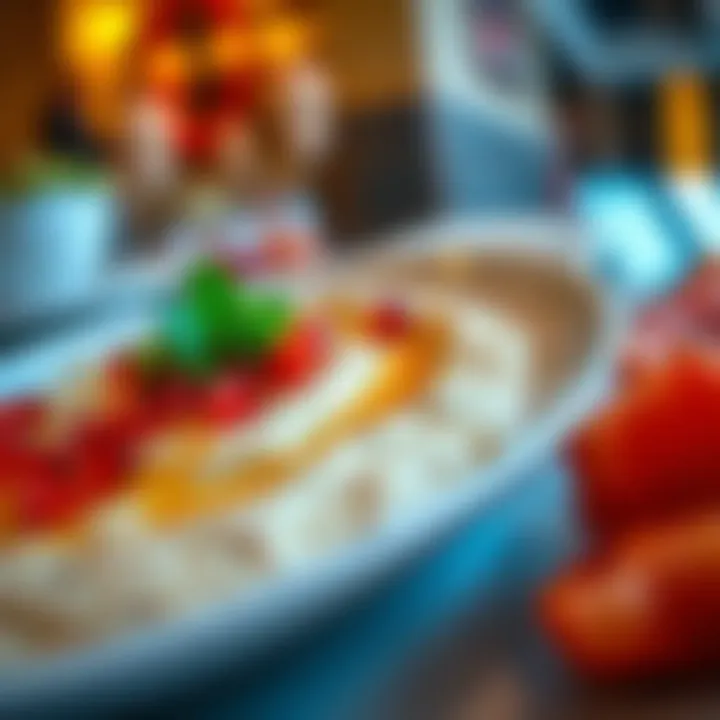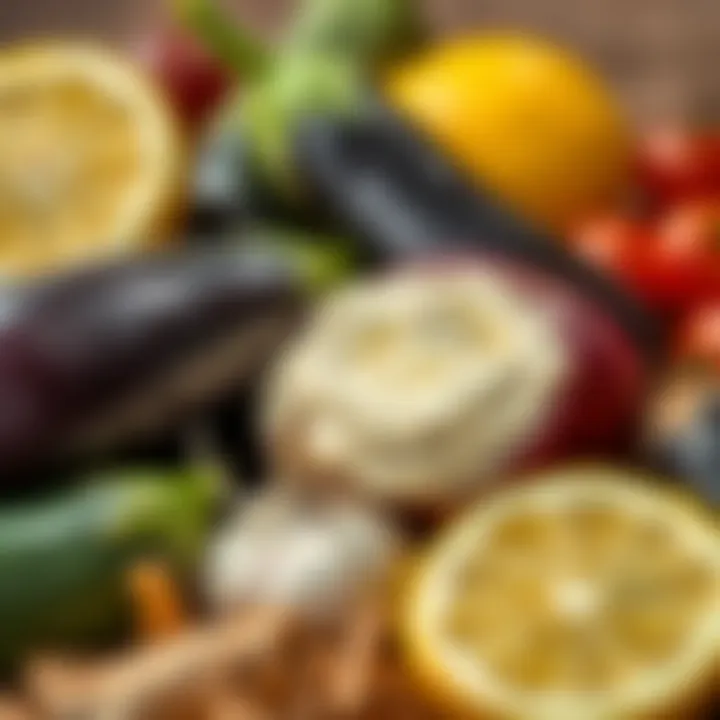Exploring Baba Ghanouj in Al Barsha: A Culinary Journey


Intro
Baba ghanouj, a dish that sings the soul of the Middle East, holds a special place in the hearts of many, especially within the bustling enclave of Al Barsha, Dubai. This creamy, smoky homage to eggplants welcomes food lovers from all walks of life. From expatriates settling into a new rhythm to tourists eager to sample the local cuisine, baba ghanouj serves as a flavorful introduction to the culinary landscape of this vibrant neighborhood.
Understanding baba ghanouj goes beyond just its ingredients. It speaks of tradition, warmth, and the communal spirit of sharing meals. In many households, the process of making this dish isn't just about following a recipe; it’s a rite of passage, a chance to connect with one’s heritage. This article seeks to explore not only the rich tapestry that makes up baba ghanouj but also its contemporary relevance in Al Barsha's diverse dining scene.
With the growing intercultural exchanges in Al Barsha, we will delve into the historical significance of baba ghanouj, as well as its evolving variations as chefs infuse modern twists into this age-old dish. Additionally, we will highlight notable eateries that are championing authentic recipes alongside innovative culinary interpretations of baba ghanouj. This exploration will provide clarity on how this beloved dish harmonizes tradition with the trends in today’s culinary world, resonating with locals and visitors alike.
Intro to Baba Ghanouj
Baba ghanouj is not just a dish; it’s a flavorful narrative woven into the rich tapestry of Middle Eastern cuisine. This delectable combination of roasted eggplant, tahini, garlic, and lemon juice brings together both texture and taste. As we delve into the world of baba ghanouj, it becomes clear that understanding its roots and cultural significance is vital to appreciating its place on the tables in Al Barsha.
Culinary Origins
Tracing the origins of baba ghanouj can be akin to piecing together a family tree. The dish has its roots in the Middle East, where variations have flourished and morphed over centuries. Some believe it originated in ancient times as a way to utilize the bountiful harvest of eggplants. Other accounts suggest it has ties to the Levantine regions, specifically Lebanon and Syria, where the flavors and preparation methods would diverge, creating a delightful spectrum of tastes.
In crafting baba ghanouj, the magic unfolds primarily through roasting the eggplant, which imparts a smokiness that enhances its flavor profile. The interaction of the eggplant with tahini, a paste made from sesame seeds, becomes a smooth symphony of richness and earthiness. This historical dish has not just been a staple but a canvas reflecting local ingredients and culinary practices.
Cultural Significance in Middle Eastern Cuisine
Baba ghanouj embodies more than just an appetizer; it serves as a cultural emblem of hospitality in the Middle East. Often served as part of a meze platter, it holds a special place in gatherings and festive occasions. Whether at a family dinner or a bustling market, its presence signifies warmth and togetherness.
- Symbol of Generosity: In many cultures, sharing food is viewed as an act of kindness. Baba ghanouj invites guests to dip, savor, and relish the experience.
- Culinary Versatility: The adaptability of baba ghanouj allows it to pair seamlessly with various dishes, creating a bridge between flavors. Be it alongside fresh pita or salads, its versatility fosters a connection among cuisine from different regions.
- Tradition Meets Trend: In recent times, this beloved bowl of goodness has found its way into modern dining, championing a healthier lifestyle and reflecting current food trends focused on plant-based foods.
In Al Barsha, as the culinary scene evolves, baba ghanouj retains its esteemed position among expatriates and locals alike. It’s a dip that celebrates history while inviting contemporary interpretations, making it a dish worth exploring in depth.
Ingredients of Baba Ghanouj
The Ingredients of baba ghanouj are the backbone that gives this dish its rich flavor and creamy texture. Understanding each component not only enhances appreciation for this culinary delight but also lays the groundwork for recreating it authentically. This section delves into the essential ingredients and seasonings that make the baba ghanouj stand out in the vibrant food scene of Al Barsha.
Primary Ingredients
At the heart of baba ghanouj lies its primary ingredients, each playing a pivotal role in crafting the final dish. The staple element is the eggplant. Ideally, it should be perfectly ripe—shiny, plump, and preferably from a local market. Roasting the eggplant until it’s soft and smokey brings out a depth that can’t be replicated. The flesh becomes tender and wonderfully rich, allowing it to blend seamlessly into a creamy dip.
Next, tahini is another irreplaceable component. This sesame paste not only adds a nutty flavor but also contributes to the smoothness that’s characteristic of a good baba ghanouj. Selecting high-quality tahini is key, as the freshness of the sesame seeds dictates the overall taste.
When it comes to seasoning, garlic is often included to infuse the dish with sharpness. The usual ratio can vary, but less can be more here; balanced seasoning is vital. Lemon juice brightens the whole dish, adding a zesty kick that cuts through the richness of the sesame and eggplant.
Lastly, olive oil acts as a finishing touch that brings everything together. A drizzle of premium olive oil not only enhances the flavor but also contributes to the luxurious mouthfeel we crave in baba ghanouj.
In summary, a well-crafted baba ghanouj hinges on the quality of its ingredients. From locally sourced eggplants to artisanal tahini, every element matters—and it truly reflects in the final product.
Spices and Seasonings
While the primary ingredients form the foundation, spices and seasonings offer the opportunity to personalize baba ghanouj. These twiddles and tweaks add character and complexity, making it unique to each chef’s interpretation.
Many recipes might include cumin, often a staple in Middle Eastern culinary practices. Just a pinch can provide warmth without overwhelming the other flavors. Additionally, smoked paprika may be used by some, granting that hint of smokiness that might echo a well-roasted eggplant.
Fresh herbs—primarily parsley or mint—can also be integrated to provide a refreshing lift, contrasting beautifully with the rich base. Sprinkling chopped herbs on top before serving not only adds flavor but also elevates presentation.
Here’s a quick rundown of spices and seasonings commonly used:
- Cumin – Adds warmth and depth.
- Smoked Paprika – Introduces a subtle smokey flavor.
- Fresh Parsley – For a bright and herbal contrast.
- Mint – Offers freshness and a cooling effect.
All these elements work in concert to create the vibrant tapestry of flavors we find in baba ghanouj. The right blend of spices can elevate this dish from simple to spectacular, especially in the quest for perfection in Al Barsha's bustling food scene.
"The beauty of baba ghanouj lies in its simplicity, yet it allows for a rich diversity of flavors—perfect for chefs eager to make their mark."
Exploring the ingredients in baba ghanouj is not just about cooking; it's a peek into the cultural fabric of the region, a storytelling experience that is both delicious and meaningful.
Traditional Preparation Techniques
The crafting of baba ghanouj, while seemingly simple, involves a blend of techniques that elevate the dish into a true masterpiece. Understanding these traditional preparation methods not only showcases the artistry behind this popular dish but also enhances the taste and texture, which are critical for connoisseurs. In this section, we delve into the two fundamental techniques: roasting the eggplant and the subsequent mixing and mashing methods.


Roasting the Eggplant
Roasting is perhaps the most pivotal stage in making baba ghanouj. This method does not merely cook the eggplant; it transforms it. When eggplants are roasted, their skins blister and char, which brings a smoky flavor that is essential to the dish. This richness cannot be achieved through boiling or steaming, making roasting a crucial step.
To roast eggplant, one can opt for direct flame on a gas stove, under a broiler, or in an oven. Each method yields a slightly different flavor, but they all enhance the depth of the baba ghanouj. Once roasted, it is vital to let the eggplant cool; this allows the steam to escape while keeping the pulp moist. When selecting eggplants, look for ones that are firm and glossy.
"A well-roasted eggplant is like finding the perfect diamond in the rough; it transforms an ordinary dish into an unforgettable delight."
Key Points to Consider About Roasting:
- Heat Source: Charcoal or gas can impart a more pronounced smokiness compared to electric ovens.
- Timing: Aim for a deep char without burning, usually around 25-30 minutes at 450°F.
- Cooling Time: Allowing it to breathe post-roast helps in developing flavors.
Mixing and Mashing Methods
After roasting, the next critical step is mixing and mashing. It's here that the ingredients come together, creating the desired consistency of baba ghanouj. There are various methods for doing this, and they can influence not only the texture but also the overall flavor profile.
Some chefs prefer using a mortar and pestle, which allows for a more granular mixture and enhances the flavors through manual emulsification. Alternatively, many home cooks opt for a food processor for convenience.
When mashing, it’s essential to incorporate tahini, garlic, lemon juice, and salt into the eggplant pulp while steadily mixing. The key here is to maintain a balance between a smooth and slightly gritty texture. If you go too far with blending, you risk losing the rustic charm of the dish.
Helpful Tips for Mixing and Mashing:
- Order of Ingredients: Start with the roasted eggplant, then add tahini, followed by lemon juice and garlic. This ensures everything is well integrated.
- Texture Preference: For a chunkier baba ghanouj, limit the blending time. For a smoother texture, blend longer.
- Taste as You Go: Adjust the seasoning as you mix to achieve the perfect flavor.
In summary, mastering the traditional techniques of roasting and mixing is essential for creating a heavenly baba ghanouj. These steps might seem straightforward, but they hold the keys to achieving an authentic flavor that pays homage to the rich heritage of Middle Eastern cuisine.
Regional Variations of Baba Ghanouj
Baba ghanouj, a beloved dish from the Middle East, showcases a splendid range of flavors and textures, largely influenced by the region’s diverse cultures. Understanding the regional variations not only enhances one's appreciation for this dish but also illustrates the customs and traditions of the communities that cherish it. In exploring these variations, we unveil how different ingredients, preparation methods, and accompanying side dishes shape the experience of baba ghanouj, particularly in areas like Lebanon, Syria, and Turkey.
Lebanese Variants
Lebanon is often regarded as the birthplace of baba ghanouj, and their take on the dish is nothing short of elegant simplicity. In Lebanese recipes, the eggplant generally holds the spotlight, often roasted or charred over an open flame which imparts a smoky depth. What sets the Lebanese variant apart is the addition of tahini, which is a richly textured paste made from ground sesame seeds. This key ingredient not only adds creaminess but also an earthy flavor that enhances the eggplant.
Lebanese baba ghanouj is also typically dressed with fresh pomegranate seeds and finely chopped parsley, giving it a vibrant presentation both in flavor and visual appeal.
- Key features of Lebanese baba ghanouj:
- Roasted eggplant: Often charred for a distinct flavor.
- Tahini: Gives a smooth and rich consistency.
- Pomegranate seeds: For a delightful burst of sweetness and color.
With these nuances, Lebanese baba ghanouj stands as a testament to culinary artistry, making it a popular choice in upscale restaurants and family gatherings alike.
Syrian Twists
Meanwhile, the Syrian version of baba ghanouj carries its own charm, often incorporating additional spices to elevate its profile. In Syria, some recipes feature yogurt mixed into the dish, lending a tanginess that contrasts beautifully with the eggplant's smoky notes. Furthermore, you might encounter variations with the addition of garlic and lemon juice, enhancing the dish’s acidity and brightness.
The texture can also vary, with some prefering a chunkier style rather than the ultra-smooth blend that Lebanese variants offer. This variation can be attributed to personal preferences across different regions within Syria, where both home cooks and chefs might have their unique interpretations.
- Distinct elements of Syrian baba ghanouj:
- Yogurt addition: Contributes a creamy tang.
- Garlic and lemon: Offer sharpness and zest.
- Chunkier texture: Some like it rustic, giving a hearty feel.
Thus, the Syrian twist on baba ghanouj showcases how regional taste preferences can shape familiar dishes in exciting new ways.
Turkish Influences
Turkish cuisine also flaunts its own version of baba ghanouj, known colloquially as
Baba Ghanouj in Al Barsha
Baba ghanouj holds a special place in the culinary scene of Al Barsha, a neighborhood that blends traditional Middle Eastern flavors with modern dining experiences. This dish is not just a staple on many menus; it’s a culinary representation of cultural heritage that resonates deeply with both locals and expatriates. The popularity of baba ghanouj in Al Barsha speaks volumes about the area's diverse gastronomy, reflecting its community's love for authentic and vibrant flavors.
As people walk through Al Barsha, it's not uncommon to see groups gathered around small tables, dipping their pita into creamy baba ghanouj and sharing stories. This communal aspect emphasizes the role of food as a bridge between different cultures, making baba ghanouj more than just a dip but a shared experience.


In a neighborhood known for its multicultural environment, baba ghanouj serves as a palette that unites various culinary influences. It allows diners to dive into the heart of Middle Eastern cuisine while enjoying an environment that embraces diversity. The dish is often paired with fresh vegetables, bread, and even grilled meats, showcasing its versatile nature.
Overview of Culinary Landscape
The culinary landscape of Al Barsha is a vibrant tapestry woven with the threads of various international cuisines, making it a unique spot to explore the rich flavors of baba ghanouj. One can find restaurants that specialize in traditional preparations alongside modern eateries that put their own twist on classic recipes.
Local chefs often experiment with ingredients, utilizing fresh, organic produce sourced from markets, creating a dish that not only respects tradition but also caters to contemporary palates. The restaurants in this area often pride themselves on quality and authenticity, with many proclaiming their recipes have been passed down through generations.
Al Barsha, with its array of dining options, is essentially a melting pot where classic Middle Eastern flavors coexist with international fare. The popularity of baba ghanouj here highlights the local appreciation for dishes that tell a story while providing nourishment and comfort.
Key Eateries and Their Offerings
Several key eateries in Al Barsha showcase baba ghanouj and have garnered a loyal following:
- Zaatar W Zeit: A beloved spot known for its fresh take on traditional Lebanese dishes. Their baba ghanouj is creamy and rich and pairs beautifully with zesty tabbouleh.
- Al Hallab: A family-owned restaurant renowned for its authentic Middle Eastern flavors. The baba ghanouj here is made fresh daily, ensuring that diners enjoy the full depth of flavor.
- Karam Beirut: Combining traditional culinary methods with a modern vibe, Karam Beirut serves baba ghanouj with a unique twist, incorporating roasted nuts for added texture and depth.
- Shawarma Al Shami: This casual eatery excels at providing quick bites, with its baba ghanouj considered a must-try. Diners love pairing it with grilled skewers or warm pita.
In Al Barsha, the rise of these eateries has not only popularized baba ghanouj but also introduced the delicacy to a broader audience, ensuring this beloved dish continues to thrive amid the culinary diversity of Dubai.
> "Baba ghanouj is not just delicious, it’s a connection to our roots, to our culture, and to each other."
For those seeking to venture into the heart of Middle Eastern gastronomy, Al Barsha presents an array of options, allowing each visitor to experience baba ghanouj in ways that speak to tradition and innovation. With every bite, diners are not just tasting a dish; they are participating in a cultural dialogue that has existed for centuries.
Complementary Dishes and Pairings
Baba ghanouj is not just a standalone dish; it becomes an integral part of a culinary experience when paired with the right accompaniments. This section delves into how the flavors of baba ghanouj can be enhanced and complemented through thoughtful pairings. Understanding these complementary dishes is essential, especially for those who want to savor the authenticity of Middle Eastern cuisine in Al Barsha.
Bread Options
One of the classic companions to baba ghanouj is bread. In Middle Eastern culture, various types of bread serve as both a vessel and an enhancement to dishes. In Al Barsha, you will find several wonderful options that truly bring out the rich, smoky notes of baba ghanouj.
- Pita Bread: Soft and chewy, pita is the quintessential choice. Its pocket design makes it perfect for scooping up creamy baba ghanouj.
- Lafa Bread: This flatbread, originating from Levantine traditions, offers a thicker consistency with a slightly crispy edge. It holds up well to heavy dips like baba ghanouj.
- Maanakish: A Lebanese flatbread topped with za’atar or cheese, it provides an exciting flavor contrast to the smoothness of baba ghanouj.
Pairing these breads not only enhances the taste experience but also promotes a communal eating style that is inherent in Middle Eastern culture.
Salads and Sides
To elevate your meal, salads and sides round out the table beautifully with baba ghanouj.
- Fattoush: This vibrant salad combines mixed greens with crispy pita chips and a tangy dressing. The crunchiness of the vegetables complements the creamy texture of baba ghanouj.
- Tabbouleh: A fresh mix of parsley, tomatoes, and bulgur, this dish adds a lightness that balances the richness of baba ghanouj. The herbal notes from the parsley impart a refreshing finish.
- Pickled Vegetables: Middle Eastern meals often include an assortment of pickles, ranging from tangy to spicy. They offer a sharp contrast and cleanse the palate between bites of baba ghanouj.
Incorporating these salads and sides provides a holistic experience that is both satisfying and nourishing. It also encourages diners to explore the meal, promoting a deeper appreciation of the flavors.
"In Al Barsha, every bite becomes a cultural exchange, highlighting the rich tapestry of culinary traditions present in the community."
When enjoying baba ghanouj, the right combinations not only elevate the meal but also increase enjoyment and connection to the shared cultural narratives that define this beloved dish.
Health Aspects of Baba Ghanouj
Understanding the health aspects of baba ghanouj provides valuable insights for both culinary enthusiasts and those conscious about their dietary choices. This dish, rich in flavor and history, brings together ingredients that offer numerous health benefits, making it not just a delicious appetizer or dip but also a nutritious option in any diet.
Nutritional Value
Baba ghanouj is primarily made from roasted eggplant, tahini (sesame paste), olive oil, lemon juice, and garlic. Each ingredient plays a significant role in contributing to the dish's overall nutritional profile:
- Eggplant: A significant source of dietary fiber, eggplant helps promote digestive health. It's also low in calories, making baba ghanouj a guilt-free indulgence.
- Tahini: Packed with healthy fats and protein, tahini contributes to heart health. Moreover, it contains several vitamins and minerals, including calcium and iron, which are essential for maintaining strong bones and overall vitality.
- Olive Oil: Known for its anti-inflammatory properties, olive oil is a staple of the Mediterranean diet and is linked to lower risks of heart disease. It is high in monounsaturated fats that are beneficial for cholesterol levels.
When combined, these components create a dip that not only satisfies the taste buds but also nourishes the body. A standard serving of baba ghanouj typically contains:
- Calories: Approximately 100-120 kcal
- Fat: 8-10g, predominantly healthy fats
- Protein: 3g
- Carbohydrates: 10-15g
- Fiber: 3-4g
In essence, baba ghanouj can be a health-conscious choice for snacks or meals, appealing to both flavor seekers and health aficionados.
Dietary Considerations


While baba ghanouj is generally considered a healthy dish, there are a few dietary considerations to keep in mind:
- Allergy Risks: Some individuals may be allergic to sesame or olive oil, which can pose a risk when consuming baba ghanouj. Always check the ingredient list, especially when trying this dish in a restaurant setting.
- Sodium Levels: Depending on preparation methods, the sodium content can vary substantially. Opting for homemade versions gives more control over how much salt is added.
- Caloric Content: While it’s a relatively healthy dip, portion control is important, especially if you are watching your caloric intake. Pairing it with whole grain pita bread or fresh veggies can further bolster the health benefits while keeping the calorie count in check.
Overall, baba ghanouj, with its fresh ingredients and numerous health benefits, is ideal for anyone looking to enjoy a rich, flavorful experience while maintaining a holistic approach to nutrition. Integrating this dish into regular meals can provide delicious variety along with essential nutrients.
Crafting Baba Ghanouj at Home
Making baba ghanouj at home is not just a culinary task; it’s an experience that connects you to rich traditions and flavors. The simplicity of its core ingredients belies the deep, smoky flavor that can be attained through proper preparation. This section provides insight into the essential tools you need, along with a step-by-step recipe to guide you in your endeavor to recreate this Middle Eastern staple.
Essential Tools and Equipment
To craft the perfect baba ghanouj, having the right tools is crucial. Below are the indispensable items you'll need in your kitchen:
- Baking Tray: To roast the eggplant, a simple baking tray will do the trick.
- Oven or Grill: For roasting, you can utilize either the oven or a grill, depending on your preference for smoky flavors.
- Food Processor or Hand Masher: For blending the roasted eggplant to achieve that creamy consistency.
- Mixing Bowl: To mix all the ingredients once they are prepared.
- Measuring Cups and Spoons: Precision can elevate the dish, so having these handy for oil, tahini, and lemon juice is critical.
- Knife and Cutting Board: For chopping garlic and any additional ingredients you might want to include in your baba ghanouj.
Having these tools ready can significantly streamline the process, making it easier to embrace the art of making this dish.
Step-by-Step Recipe
Crafting baba ghanouj at home is straightforward if you follow these steps. Here’s how you can create a delightful experience in your kitchen:
- Preheat the Oven: Set your oven to 450°F (232°C). This will prepare it for roasting the eggplants.
- Prepare the Eggplant: Take one large eggplant and pierce it several times with a fork. This helps steam escape while roasting. Alternatively, you can slice it in half lengthwise to speed up the cooking time and increase the caramelization on the flesh.
- Roast the Eggplant: Place the eggplant on the baking tray and roast for about 30-40 minutes, until the flesh is tender and the skin is charred. If using a grill, turn it occasionally until it’s suitably cooked all around.
- Allow to Cool: Remove the eggplant from the oven and let it cool for a few minutes. Peeling should be done when it’s cool enough to handle.
- Scoop and Mash: Scoop the roasted flesh from the eggplant skin and place it into your mixing bowl. Use a food processor for a smoother texture or a hand masher for a rustic feel.
- Mix in Ingredients: Add 2 tablespoons of tahini, 1-2 chopped garlic cloves, the juice of one lemon, 2 tablespoons of olive oil, and salt to taste. Blend until you reach your desired consistency. You can also add a hint of cumin for an extra kick.
- Taste and Adjust: This is the most important step. Taste your baba ghanouj and adjust the seasoning. You might find that you want more lemon juice, salt, or tahini to fit your palate.
- Garnish and Serve: Transfer to a serving bowl and drizzle with a touch more olive oil. Sprinkle with chopped parsley or pomegranate seeds for a pop of color. Serve it with warm pita bread or fresh veggies.
This culinary exploration of baba ghanouj not only satisfies your taste buds but also brings together family and friends, creating memorable moments around a shared dish.
By following these steps, anyone can craft baba ghanouj in the comfort of their own home, allowing the flavors of this traditional dish to come alive in personal spaces.
Cultural Events Featuring Baba Ghanouj
The cultural events that highlight baba ghanouj serve as vibrant celebrations of heritage, community, and culinary artistry. These happenings are not merely gatherings centered around food; they are platforms where traditions are shared, and new connections are forged. In Al Barsha, these events become even more significant, as they create a fusion of flavors and cultures reflecting the vibrant mix of its inhabitants—from expatriates to natives.
Food Festivals in Dubai
Dubai hosts a myriad of food festivals throughout the year, drawing culinary enthusiasts from near and far. Among these, festivals that feature baba ghanouj showcase more than just the dish; they celebrate the heart of Middle Eastern cuisine. Such festivals often spotlight local chefs, who not only serve authentic dishes but infuse their own creative twists, making each tasting experience unique.
- Taste of Dubai: This annual event brings together food lovers and numerous food vendors under one roof. Visitors can relish a variety of dishes, with baba ghanouj often taking center stage, accompanied by fresh, warm pita bread.
- Dubai Food Festival: Extend beyond just tasting food; this event emphasizes the culinary diversity of the city. Baba ghanouj stalls frequently offer cooking demonstrations, where seasoned chefs share their secrets on perfecting this eggplant appetizer, engaging guests with tales of its cultural roots.
These festivals do more than fill your stomach; they cultivate an understanding of diverse cuisine. Attendees leave not only full but enriched with knowledge about the histories and stories behind each dish.
Community Gatherings Celebrating Arabic Cuisine
What better way to bond with people than over a shared meal? Community gatherings focusing on Arabic cuisine often include baba ghanouj in their spread, serving as a beloved appetizer. These events are essential, especially in multicultural settings like Al Barsha, where people from various backgrounds come together to appreciate the rich culinary tradition of the Arab world.
- Neighborhood Potlucks: These informal community events see residents bringing homemade dishes. Baba ghanouj often finds its way to these tables, symbolizing hospitality and the warmth of sharing.
- Cultural Heritage Days: Organized by local councils or expat groups, these events are designed to educate and immerse attendees in the vibrant cultural practices of the Arab world. Baba ghanouj features prominently as a staple dish, drawing particular attention due to its healthy ingredients and rich flavor.
A gathering isn't just about the food; it is about weaving together stories, creating friendships, and fostering unity. Baba ghanouj acts as a culinary ambassador, bridging gaps and enriching the experience of everyone coming together in Al Barsha.
Closure
In understanding the culinary tapestry of Al Barsha, the importance of baba ghanouj cannot be overstated. This dish serves as more than just a staple; it encapsulates the very essence of Middle Eastern hospitality and cultural exchange. Throughout the article, we’ve explored the rich history, the significance of quality ingredients, and the diverse traditions surrounding the preparation of baba ghanouj.
Summation of Cultural and Culinary Impact
Baba ghanouj reflects centuries of culinary heritage, illustrating how food can connect people across generations and cultures. Its ingredients typically tell a story, highlighting the preferences and agricultural products of various regions in the Middle East. In Al Barsha, this dish is embraced not only by locals but also by expatriates and visitors who seek genuine culinary experiences. It's common to see families gathering around a table with baba ghanouj as the centerpiece, reinforcing ties of tradition and friendship.
Moreover, this dish's ability to adapt to modern dining trends has made it a popular choice in contemporary menus throughout Dubai. Restaurants experiment with flavors, sometimes adding innovative twists while still honoring the traditional essence.
As a result, baba ghanouj stands as a testament to the idea that food is an art form, capable of evolving while retaining core values and meanings. Engaging with baba ghanouj in Al Barsha certainly enriches one’s culinary journey and fosters a greater appreciation for the Middle Eastern cuisine.
The Future of Baba Ghanouj in Modern Dining
Looking ahead, the future of baba ghanouj in modern dining seems promising. With an increasing focus on healthy eating and plant-based diets, the dish naturally aligns with these values. It provides a nutritious option packed with vitamins, healthy fats, and a delightful flavor profile, making it a favorite among health-conscious diners.
As culinary trends shift, we might also see new interpretations of baba ghanouj. Chefs in Al Barsha could continue to innovate, incorporating local flavors or contemporary techniques that could redefine how this beloved dish is served.
Additionally, community events and food festivals will likely feature baba ghanouj, helping to keep the dish in the spotlight. These gatherings foster connection and community, while also introducing baba ghanouj to new audiences eager to explore Middle Eastern cuisine.
In summary, as we reflect on baba ghanouj, it emerges not just as a dish but as a story of tradition and the possibilities of culinary exploration in Al Barsha. It continues to be both a comfort and a frontier for creativity in modern gastronomy.















